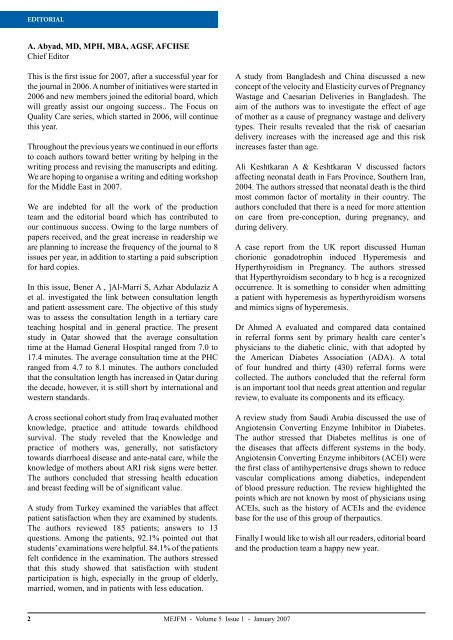Contents - Middle East Journal of Family Medicine
Contents - Middle East Journal of Family Medicine
Contents - Middle East Journal of Family Medicine
You also want an ePaper? Increase the reach of your titles
YUMPU automatically turns print PDFs into web optimized ePapers that Google loves.
EDITORIALA. Abyad, MD, MPH, MBA, AGSF, AFCHSEChief EditorThis is the first issue for 2007, after a successful year forthe journal in 2006. A number <strong>of</strong> initiatives were started in2006 and new members joined the editorial board, whichwill greatly assist our ongoing success.. The Focus onQuality Care series, which started in 2006, will continuethis year.Throughout the previous years we continued in our effortsto coach authors toward better writing by helping in thewriting process and revising the manuscripts and editing.We are hoping to organise a writing and editing workshopfor the <strong>Middle</strong> <strong>East</strong> in 2007.We are indebted for all the work <strong>of</strong> the productionteam and the editorial board which has contributed toour continuous success. Owing to the large numbers <strong>of</strong>papers received, and the great increase in readership weare planning to increase the frequency <strong>of</strong> the journal to 8issues per year, in addition to starting a paid subscriptionfor hard copies.In this issue, Bener A , ]Al-Marri S, Azhar Abdulaziz Aet al. investigated the link between consultation lengthand patient assessment care. The objective <strong>of</strong> this studywas to assess the consultation length in a tertiary careteaching hospital and in general practice. The presentstudy in Qatar showed that the average consultationtime at the Hamad General Hospital ranged from 7.0 to17.4 minutes. The average consultation time at the PHCranged from 4.7 to 8.1 minutes. The authors concludedthat the consultation length has increased in Qatar duringthe decade, however, it is still short by international andwestern standards.A cross sectional cohort study from Iraq evaluated motherknowledge, practice and attitude towards childhoodsurvival. The study reveled that the Knowledge andpractice <strong>of</strong> mothers was, generally, not satisfactorytowards diarrhoeal disease and ante-natal care, while theknowledge <strong>of</strong> mothers about ARI risk signs were better.The authors concluded that stressing health educationand breast feeding will be <strong>of</strong> significant value.A study from Turkey examined the variables that affectpatient satisfaction when they are examined by students.The authors reviewed 185 patients; answers to 13questions. Among the patients, 92.1% pointed out thatstudents’ examinations were helpful. 84.1% <strong>of</strong> the patientsfelt confidence in the examination. The authors stressedthat this study showed that satisfaction with studentparticipation is high, especially in the group <strong>of</strong> elderly,married, women, and in patients with less education.A study from Bangladesh and China discussed a newconcept <strong>of</strong> the velocity and Elasticity curves <strong>of</strong> PregnancyWastage and Caesarian Deliveries in Bangladesh. Theaim <strong>of</strong> the authors was to investigate the effect <strong>of</strong> age<strong>of</strong> mother as a cause <strong>of</strong> pregnancy wastage and deliverytypes. Their results revealed that the risk <strong>of</strong> caesariandelivery increases with the increased age and this riskincreases faster than age.Ali Keshtkaran A & Keshtkaran V discussed factorsaffecting neonatal death in Fars Province, Southern Iran,2004. The authors stressed that neonatal death is the thirdmost common factor <strong>of</strong> mortality in their country. Theauthors concluded that there is a need for more attentionon care from pre-conception, during pregnancy, andduring delivery.A case report from the UK report discussed Humanchorionic gonadotrophin induced Hyperemesis andHyperthyroidism in Pregnancy. The authors stressedthat Hyperthyroidism secondary to b hcg is a recognizedoccurrence. It is something to consider when admittinga patient with hyperemesis as hyperthyroidism worsensand mimics signs <strong>of</strong> hyperemesis.Dr Ahmed A evaluated and compared data containedin referral forms sent by primary health care center’sphysicians to the diabetic clinic, with that adopted bythe American Diabetes Association (ADA). A total<strong>of</strong> four hundred and thirty (430) referral forms werecollected. The authors concluded that the referral formis an important tool that needs great attention and regularreview, to evaluate its components and its efficacy.A review study from Saudi Arabia discussed the use <strong>of</strong>Angiotensin Converting Enzyme Inhibitor in Diabetes.The author stressed that Diabetes mellitus is one <strong>of</strong>the diseases that affects different systems in the body.Angiotensin Converting Enzyme inhibitors (ACEI) werethe first class <strong>of</strong> antihypertensive drugs shown to reducevascular complications among diabetics, independent<strong>of</strong> blood pressure reduction. The review highlighted thepoints which are not known by most <strong>of</strong> physicians usingACEIs, such as the history <strong>of</strong> ACEIs and the evidencebase for the use <strong>of</strong> this group <strong>of</strong> therpautics.Finally I would like to wish all our readers, editorial boardand the production team a happy new year.2MEJFM - Volume 5 Issue 1 - January 2007
















